Table Of Contents
Sound Meter
The next circuit has two problems.
Connecting an electret mic directly to the input of a microcontroller chip is an unwise thing to do. In the circuit below, the voltage across the microphone will never rise above 50% of rail voltage for the chip to detect a HIGH.
The other mistake is the 1k resistors on the LEDs.
At a supply voltage of 3v, the current through each 1k will be less than 2mA. It is not known if more than one LED illuminates at a time, but this current would be shared between 2, 3 or 4 LEDs and they would be barely visible. The resistors should be 100R to 220R.
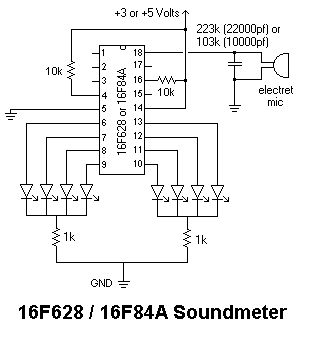
More from EFY:
LEDs in Series
The LEDs suggested for the circuit are HIGH-BRIGHT yellow LEDs. These LEDs have a characteristic voltage-drop of 2v - 2.6v. The normal characteristic is 2.3v. The drop across the 5 LEDs is 11.5v.
The transistor will drop about 0.3v between collector and emitter and the protection diode will drop about 0.6v. This makes a total of 12.4v. Where is the allowance for the voltage drop across the 220R?
What is the purpose of the 4k7 resistors on the base of each BC337? The output of the chip will produce either a HIGH or a LOW.
This is another circuit that obviously has not been tested.
I received a reply from Electronics For You Magazine. They stated their LEDs had a voltage drop of 1.95v and that’s why their circuit worked!!
They missed my point completely. What about MY LEDs. And what about YOUR LEDs?
They only produced one sample in a laboratory. Big mistake. That’s why I get others to build a project before I put it in front of 250,000 readers. The circuit does not work reliably.
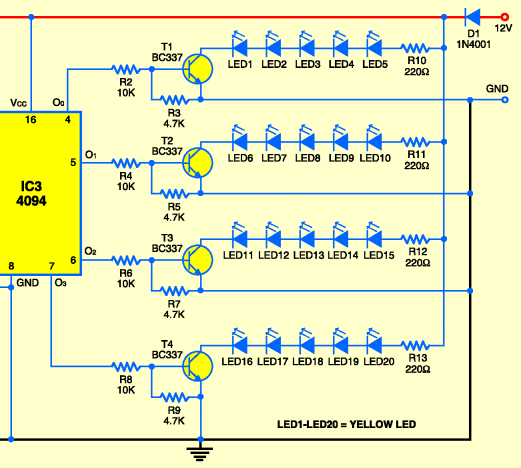
And still more from EFY:
1k load resistor
In the circuit below, what is the purpose of the 1k resistor?
The LED and 470R will hold pin 2 HIGH when the output of the OP-AMP is HIGH as the characteristic voltage across the LED is about 1.7v and pin 2 must drop below 1/3 of rail voltage to activate the 555.
But the main problem with the circuit is the single LDR to detect when a person enters a room. The circuit is sensitive enough to detect the shadow of a person passing the LDR but a circuit with this amount of sensitivity will also detect the ambient light level and false-trigger.
A much-better design is shown in the next circuit. It uses two photo-diodes to compare the background light level and only register when there is a difference. This allows the day to shine or the sky to overcast, without affecting the alarm.
The circuit has been bread-boarded and put into a movie HERE. (1Meg)
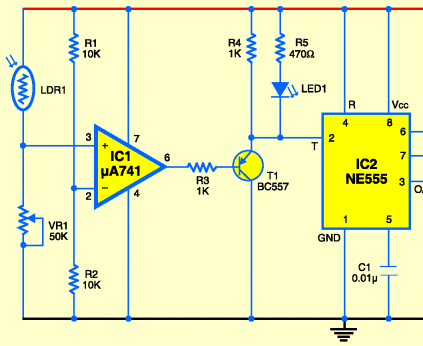
The improved circuit:
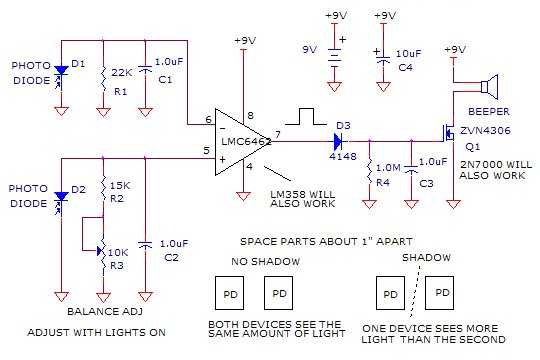
As I have said before. Ask yourself: Will the circuit work in all types of different conditions and surroundings? What is the purpose of each component? Is each component necessary? How much current does the circuit take in quiescent (“idle”) mode? Are there better and cheaper ways to do the same thing?
That’s why you need to study so many circuits, to get an idea of how to design the cheapest and best arrangement.
You will learn more for other people’s mistakes than any text book on electronics.
Text books assume everything you construct will work.
After all, how many text books have a section “If it doesn’t work?”
It’s only when a project fails to work, that you will start to learn how the circuit works.
That’s why you can never get enough “mistakes” to investigate and analyse.
Faulty Design
The next circuit is not a mistake but the author does not mention the output does not rise above 1.2v for a 3v supply. This is only a 40% rise and will not register as a HIGH, for many devices such as “gates” especially those with a Schmitt trigger input. They need at least 65% of rail voltage to detect a HIGH.
Secondly, the author has neglected to inform the output needs to be connected to a very high impedance to allow the circuit to rise to its maximum output.
The reason is the 4M7 in the circuit is the component that “pulls” the output HIGH and if the output is connected to a circuit with an input of say 4M7, the output will rise to less than 1v.
There is no problem with the oscillator producing a LOW as the two transistors are turned on by “regenerative action” and the output pulls LOW with considerable “force” or “ability” or “current.”
The circuit starts its cycle by charging the 4n7 via the 100M resistor. The 4M7 and 100M and 100M form a voltage divider that put a small voltage on the base of the lower transistor.
The 4n7 charges and puts a voltage on the base of the upper transistor. The emitter of the upper transistor sees a voltage that is about 0.6v lower than the base and this voltage is placed on the emitter of the lower transistor. When this emitter voltage is 0.6v higher than the base, the transistor turns on and holds the emitter at its present potential. The transistor cannot pull itself closer to the 0v line as this would remove some of the “turn-on” voltage on the base.
However the lower transistor remains rigid and the top transistor turns on more as the 4n7 charges.
The voltage on the collector of the top transistor reduces and this pulls the top plate of the 0.1u capacitor towards the 0v rail. Since this action is happening very fast, the capacitor does not have time to charge and the bottom plate is also pulled towards the 0v rail
The bottom of the 0.1u is connected to the base of the lower transistor and this is also taken lower.
This turns on the bottom transistor and the result is the top transistor is turns on more. This is the regenerative action mentioned above and the two transistors turns each other ON more and more until the they are both turned on FULLY.
This whole action occurs without the need for the 4n7 to charge any further and that’s why the action is called regenerative.
We now have the situation where the two transistors are turned on and the output is LOW. The very small voltage or “energy” stored in the 0.1u is now passed into the base of the lower transistor to keep it in this “turned-on” condition and this produces the 2mS LOW on the output waveform.
After 2mS, the lower transistor cannot be kept turned on and as soon as its turns off slightly, the top transistor is turned off slightly as well and the output rises. This happens very quickly and the top plate of the capacitor rises and takes the lower plate with it. This turns off the lower transistor and the two transistor are very quickly turned off fully.
As mentioned above, the output will not rise above 1.2v for a 3v supply and this must be taken into account when connecting it to another stage.
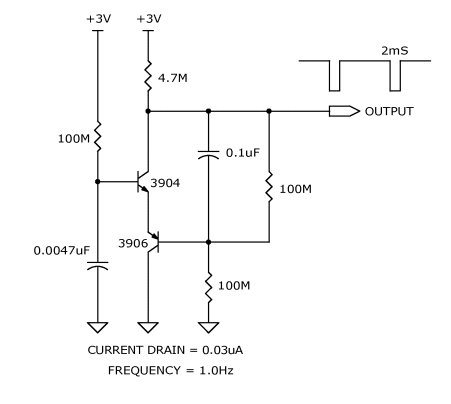
Wind Turbine Water Heating
Wind turbine generators are used primarily for electricity generation. The power used can be stored in a battery bank or connected to the mains. In very strong winds, and/or when the batteries are fully charged a wind turbine may generate more current than the batteries can handle. Therefore a dump load is often used to divert the extra energy to heat water so it is not wasted and so that the wind turbine does not spin so quickly that it is damaged.
Diversion Load Water Heating

Pictured above is a typical 12V water heating element (200 Watt power). When used as a diversion (dump) load, such an element is connected to the batteries via a charge regulator. When the regulator detects that the batteries are fully charged, it diverts the generated electricity to the element which heats water.
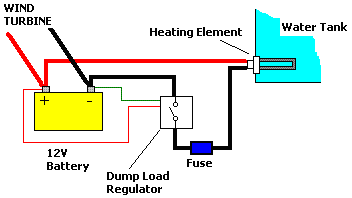
Direct Wind Turbine Water Heating
It is not usually possible to connect a 12 Volt water heating element directly to the output from a wind turbine. The voltages generated by a 12 Volt wind turbine are typically far in excess of their nominal 12 Volt rating - values of over 50 Volts can often be recorded in heavy winds which would rapidly burn out the heating element when you need it most.

In order to prevent the heating element from receiving fluctuating over-voltages a small battery should be used as a buffer between the wind turbine output and the heating element. A 12V motorcycle battery is perfect for this task - no more powerful than 4 amp hours / 50 cold cranking amps, and it should be a lead-acid battery which can be refilled with water. A sealed gel type battery or dry cell should not be used.
The heating element chosen must be closely matched to the power output of the wind turbine. If the element is too small (low wattage), then too much power will go through it and it may be damaged. If it is too large (high wattage), the wind turbine will not be able to start up spinning unless the wind is very strong.
The only fault with the article is the mention that a small heating element will be damaged if placed in the circuit above. This is not true. If a low-wattage element is placed in the circuit, it will only draw (take) its rated wattage as the maximum voltage is limited to 12v via the 12v battery.
But the rest of the statements are true and worth noting.
More on Wind
While on the topic of wind generation, a supplier of wind generators provided absolutely no wattage output from his generator, but a simple voltage produced at various RPM:
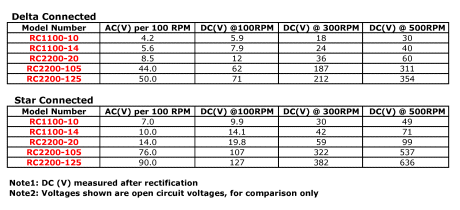
I emailed him and said a voltage output did not provide any information what-so-ever as to the energy delivered by the generator.
His reply was as follows:
The comparison chart only shows the relative comparison of open circuit voltage versus RPM for each PMG in both Star and Delta configuration.
It would not be possible to show the current at each of these speeds, without knowing the applied torque at those same RPMs, and since these generators are supplied to customers for a variety of applications, there is no “standard” torque which can be used to best demonstrate the current (and hence overall power) of the generators at all speeds.
What he is saying is totally untrue. You do not have to know the input torque and, in fact the input torque is not needed or wanted.
The way to test the generator is to place it on a test-bed and connected to a variable speed motor to the drive-shaft. Bring the motor up to 100RPM and measure the voltage at no load. Place a load on the motor of 1 amp and note the RPM will decrease. Increase the RPM to 100 and measure the voltage.
Do the same for 2, 3, 4, 5, 6, amp etc and you will find the voltage will drop off as the current increases. When you multiply the voltage by the current for each of the set of results, you will come up a value that is almost constant! This is the wattage deliverable by the generator at 100RPM.
Do the same for 200, 300, 400, 500, 600RPM and you will have the capability of the generator. Not once did we mention anything about the torque or “power” entering the generator.
You can do this for star and delta wiring and tabulate the results.
Here is a diagram of how to connect the six wires that emerge from the generator:
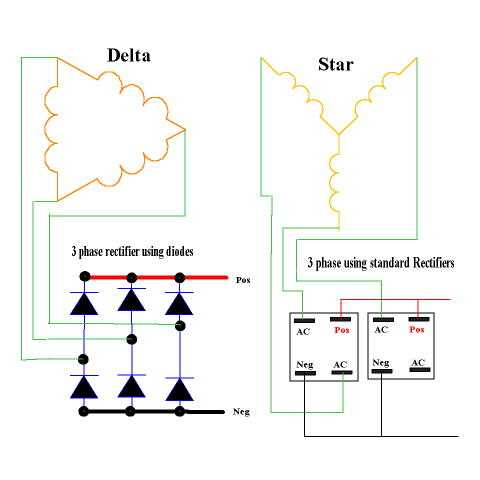
There are basically two ways to wire a 3 phase alternator, star (or Wye) and Delta. With Delta you get a lower voltage but a higher current. In star you get a higher voltage but less amps. You can calculate these by using the square root of 3 (1.732 ). Each coil set is a “phase” of the alternator so when you measure voltage, ohms or current of one phase of the alternator you measure the “phase”. Once you know what the output will be from one phase you can calculate the “line” output in either delta or star. The line voltage would be measured from any 2 of the 3 outputs. If one phase measured 22 volts and 10 amps then the star configuration would produce 38 volts and 10 amps (22 x 1.732 ). The amps remain the same as the phase measurement because the star is basically in series to another phase. In Delta you would get 22 volts at 17.32 amps (10 amps x 1.73 ). If you calculate this: 22 volts x 17.32 = 381 watts and 38 x 10 = 380 watts… so what is the advantage?
Typically the resistance in Delta is 1/3 the resistance of star. If the resistance of star was 1.5 ohms we could calculate the output. Lets assume the test was at 600 rpm, we achieved 38 volts in star so at 1000 rpm we would get 62.5 volts less battery voltage of 12.6 = 49.9 volts / 1.5 ohms = 33.26 amps * 12.6 = 419 watts… not too bad. Now in delta we had 22 volts at the same rpm. So at 1000 rpm we get 37 volts - 12.6 battery = 24.4 volts / .5 ohms = 48.8 amps * 12.6 = 614 watts. Almost a 200 watt gain !!! The advantage of star is the higher voltage at lower rpm which means our unit would have to reach 201 rpm to start charging at 12.6v while the Delta connection would require 340 rpm to start charging.
3 phase power is typically 150% more efficient than single phase in the same power range. In a single phase unit the power falls to zero three times during each cycle, in 3 phase it never drops to zero. The power delivered to the load is the same at any instant. Also, in 3 phase the conductors need only be 75% the size of conductors for single phase for the same power output.
Now we come to a very simple fault. The two LEDs are designed to identify the direction of rotation of the motor.
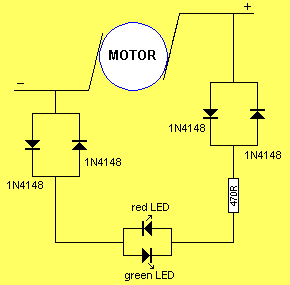
Why has the designer put signal diodes in the circuit? The Light Emitting Diode is a DIODE and will only conduct when the voltage is in the correct direction.
The additional signal diodes do not perform any function at all. It is surprising the editor of the magazine did not see this when reviewing the article.
The corrected diagram is:
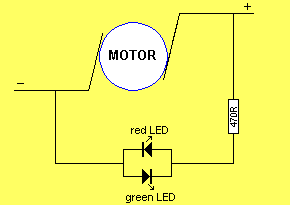
Quick Links
Legal Stuff
Social Media


